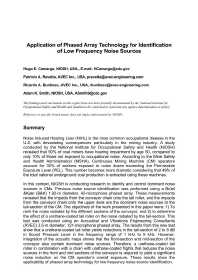Mining Publication: Application of Phased Array Technology for Identification of Low Frequency Noise Sources
Original creation date: October 2008
Noise Induced Hearing Loss (NIHL) is the most common occupational disease in the U.S. with devastating consequences particularly in the mining industry. A study conducted by the National Institute for Occupational Safety and Health (NIOSH) revealed that 90% of coal miners have hearing impairment by age 50, compared to only 10% of those not exposed to occupational noise. According to the Mine Safety and Health Administration (MSHA), Continuous Mining Machine (CM) operators account for 30% of workers exposed to noise doses exceeding the Permissible Exposure Level (PEL). This number becomes more dramatic considering that 49% of the total national underground coal production is extracted using these machines. In this context, NIOSH is conducting research to identify and control dominant noise sources in CMs. Previous noise source identification was performed using a Bruel &Kjaer (B&K) 1.92-m diameter, 42-microphone phased array. These measurements revealed that the impacts from the conveyor chain onto the tail roller, and the impacts from the conveyor chain onto the upper deck are the dominant noise sources at the tail-section of the CM. The objectives of the work presented in this paper were: 1) To rank the noise radiated by the different sections of the conveyor, and 2) to determine the effect of a urethane-coated tail roller on the noise radiated by the tail-section. This test was conducted using an Acoustical and Vibrations Engineering Consultants (AVEC) 3.5-m diameter, 121-microphone phased array. The results from this new test show that a urethane-coated tail roller yields reductions in the tail-section of 2 to 8 dB in Sound Pressure Level in the frequency range of 1 kHz to 5 kHz. However, integration of the acoustic maps shows that the front-section and mid-section of the conveyor also contain dominant noise sources. Therefore, a urethane-coated tail roller in combination with a chain with urethane-coated flights that reduces the noise sources in the front and mid sections of the conveyor is required to yield a significant noise reduction on the overall exposure of the CM operator. These results show the applicability of phased array technology for low frequency noise source identification.
Authors: HE Camargo, PA Ravetta, RA Burdisso, AK Smith
Conference Paper - October 2008
NIOSHTIC2 Number: 20034678
Proceedings of the 13th International Conference on Low-Frequency Noise and Vibration and Its Control, Tokyo, Japan, October 21-23, 2008. Tokyo, Japan: Institute of Noise Control Engineering of Japan, 2008; :88-96
See Also
- Cross-Sectional Survey of Noise Exposure in the Mining Industry
- Determining Underground Roof Bolting Machine Operators Noise Exposure Using Laboratory Results
- A Dual Sprocket Chain as a Noise Control for a Continuous Mining Machine
- Modified Tail Section Reduces Noise on a Continuous Mining Machine
- Noise Exposure in Longwall Mining and Engineering Controls Research
- Noise Source Identification on a Continuous Mining Machine
- A Technique for Estimating the Sound Power Level Radiated by Pneumatic Rock Drills and the Evaluation of a CSIR Prototype Rock Drill with Engineering Noise Controls
- Technology News 453 - Navigation and Control of Continuous Mining Systems for Coal Mining
- Underground Evaluation of Coated Flight Bars for a Continuous Mining Machine
- Water Well Safety Bits: Health And Safety Information For The Water Well Industry
- Page last reviewed: 9/21/2012
- Page last updated: 9/21/2012
- Content source: National Institute for Occupational Safety and Health, Mining Program


 ShareCompartir
ShareCompartir
